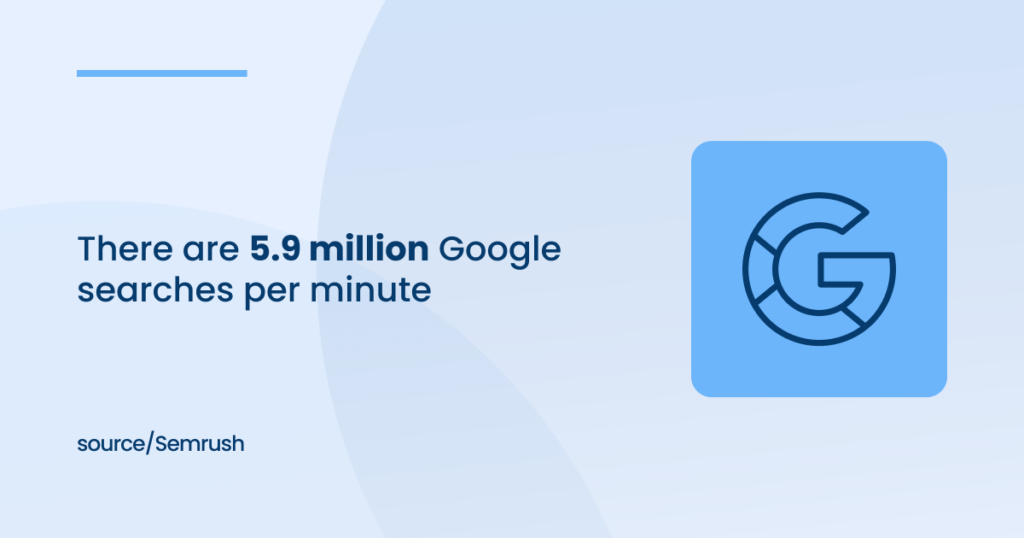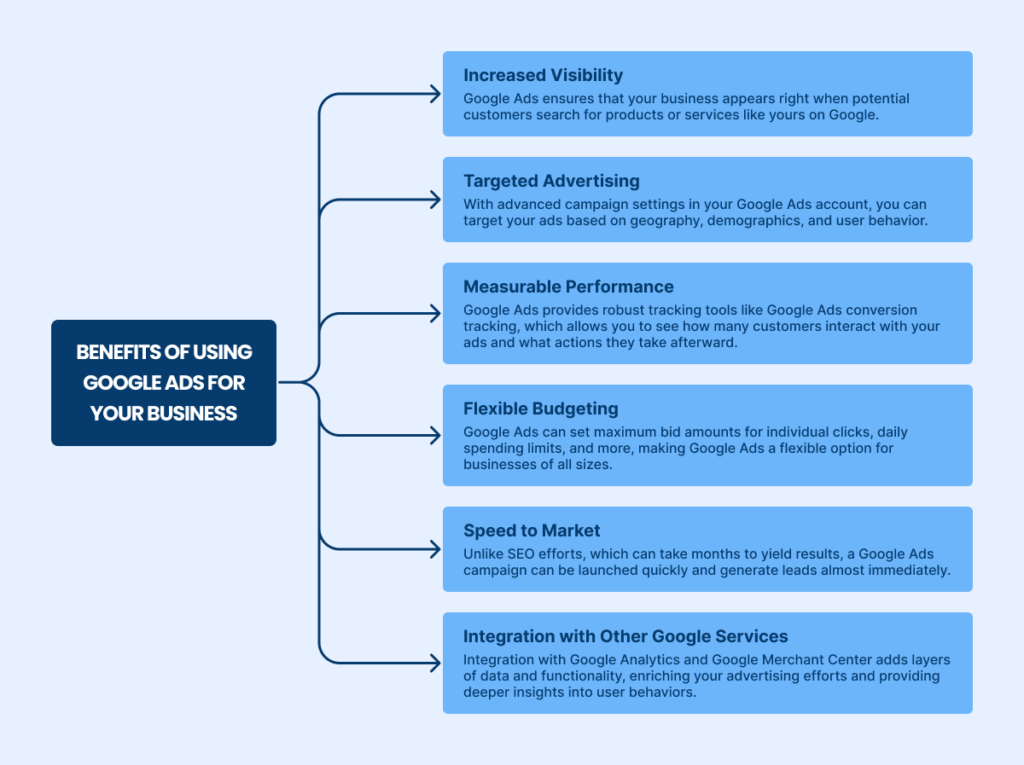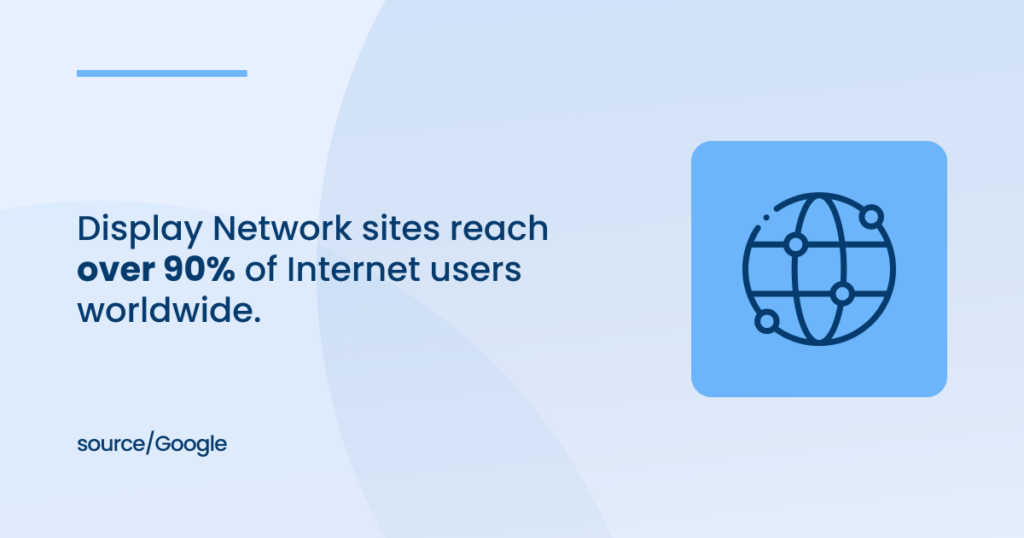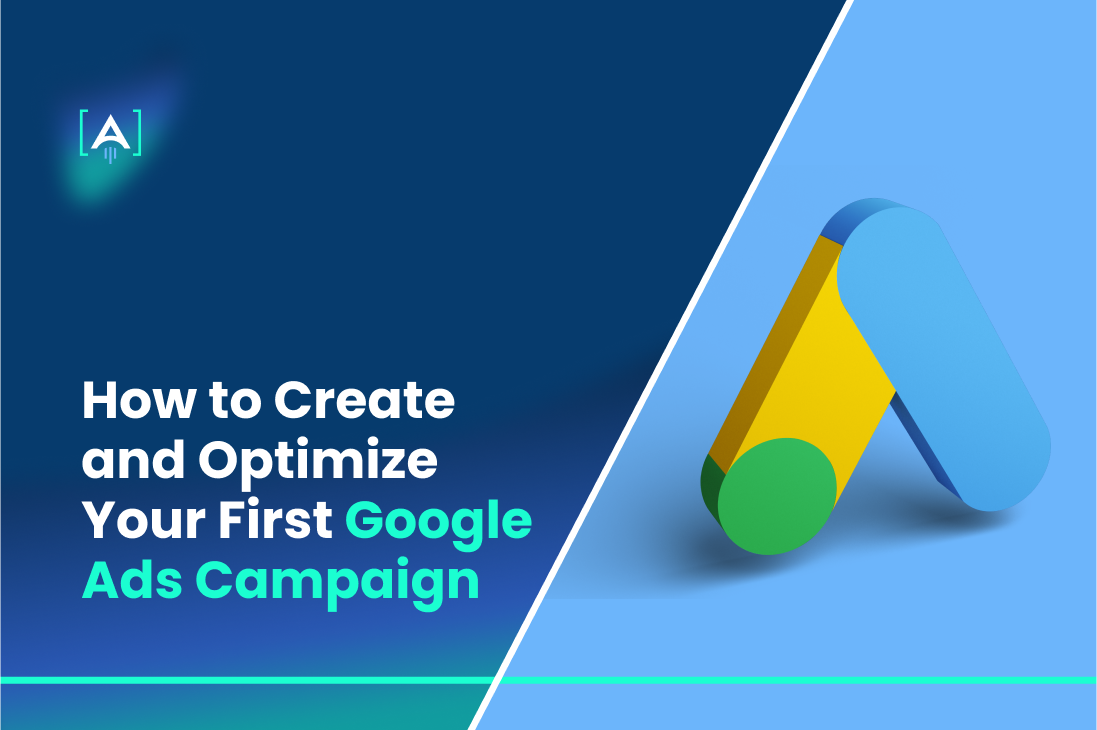Have you ever wished your website could appear right when someone searches for exactly what you offer? With Google Ads, you can turn that wish into reality.
Google Ads is a powerful digital advertising platform developed by Google. It allows businesses and individuals to display ads across Google’s vast network, including search results, websites, apps, and videos.

According to Statista, most of Google’s 305.63 billion U.S. dollar record revenues originated from advertising, especially online searches in 2023.
Source: Digital advertising spending in the United States, Statista
If you want to maximize your online advertising ROI and get profound results, consider partnering with a specialized Google Ads agency.
However, the blog post will introduce you to the key strategies of Google Ads campaigns, from setting your goals to writing irresistible ad copy that gets clicks.
What is Google Ads?
Google Ads is a comprehensive advertising platform developed by Google, which enables businesses and marketers to run ad campaigns across Google’s extensive network. This includes search engine results pages, affiliated websites, and apps.
Google Ads operates on a pay-per-click (PPC) model, where advertisers pay only when users click on their ads.
This tool is highly versatile, allowing the creation of various Google Ads campaign types, such as search ads, video ads, and display ads, each tailored to meet specific marketing goals and reach different audience segments.
Advertisers can manage their campaigns through the Google Ads Manager, a centralized dashboard where they can adjust campaign settings, monitor performance, and optimize based on data insights.
Benefits of Using Google Ads for Your Business

Understanding the Google Ads Auction and Pricing
The Google Ads auction determines which ads appear on Google’s advertising spaces and how much each click will cost the advertiser.
It’s not just the highest bid that wins but a combination of factors, including bid amount, ad quality, and the expected impact of extensions and other ad formats.
The Auction Process
- Ad Eligibility: Initially, ads are evaluated to ensure they meet the eligibility criteria to enter the auction. This includes having a sufficient bid and being relevant to the user’s search query.
- Ad Rank Calculation: Google calculates an Ad Rank for each ad, which determines its placement on the page. Ad Rank is based on the bid amount, the quality of the ad (ad group relevance, landing page quality, and click-through rate), and the expected impact of ad formats.
- Cost-per-Click (CPC): If your ad is clicked, the actual CPC you pay is determined by the ad rank of the next highest ad below yours divided by your quality score plus one cent. This means you often pay less than your maximum bid.
Factors Affecting Google Ads Cost
- Bid Strategy: Whether you choose manual or automated, bid strategies can affect your costs. Automated strategies adjust your bids in real-time to maximize your budget for clicks or conversions.
- Quality Score: This is Google’s rating of the quality and relevance of your keywords and ads. A higher quality score can lead to lower costs and better ad positions.
- Competition: In highly competitive markets, bids tend to be higher due to more advertisers bidding on the same keywords.
- Ad Formats: Adding enhancements like ad extensions can improve your click-through rate and thus your quality score, potentially lowering costs.
Understanding these components and their interaction within your Google Ads settings is vital for optimizing your ad campaigns and achieving cost-effective results.
By effectively managing your ad groups and utilizing the right types of campaigns, you can significantly enhance your visibility, drive more traffic, and ultimately achieve higher conversions.
Setting Up Your First Campaign
Setting up your first Google Ads campaign is a pivotal step in harnessing the power of digital advertising to reach new customers and grow your business.
The Google Ads platform offers a multitude of Google Ads campaign types tailored to different marketing goals, from boosting website traffic to enhancing brand visibility. Here’s a step-by-step guide to getting started:
Defining Your Campaign Goals
Defining clear, measurable goals is essential for creating effective Google Ads campaigns. Your objectives will guide every decision, from budget allocation to choosing the right type of ads.
Let’s break down some common goals:
Brand Awareness
Brand awareness campaigns are designed to introduce your brand to a wider audience and make it recognizable. These campaigns are not about immediate sales but about embedding your brand in the consumer’s mind, so they think of you when they’re ready to purchase.
- Campaign Types: For brand awareness, image ads and video ads on the Google Display Network are particularly effective. They allow you to leverage creative visuals to capture attention and make a memorable impression.
- Ad Spend: Start with a modest ad spend while you test which messages and visuals resonate with your audience. Scale up as you refine your approach.
- Metrics: Track reach and impressions to gauge how widely your brand is being seen. Google Ads provides metrics like the number of times your ads were on screen and the geographic distribution of viewers.
- Google Ads Settings: Utilize targeting options to define the demographics and locations of the audience you want to reach, ensuring your brand is introduced to potential customers who are most likely to engage.
Lead Generation
Source: Marketing Charts
Lead generation campaigns aim to collect information from prospects interested in your product or service, enabling further engagement through personalized communications.
- Campaign Types: Google search ads are highly effective for lead generation. By targeting specific keywords related to your products or services, you can capture users’ attention when they show interest.
- Ad Spend: Allocate the budget based on the competitiveness of the keywords you target. Higher competition keywords may require a larger budget to compete effectively.
- Metrics: Use Google Ads conversion tracking to monitor how many users complete the desired action, such as filling out a contact form or signing up for a newsletter.
- Google Ads Settings: Optimize your campaigns by using ad extensions like callouts, which can provide additional information and links directly to a sign-up page.
Sales Conversion
The ultimate goal of many campaigns is to drive sales. Whether you’re an e-commerce site looking to increase transactions or a B2B service provider aiming for contract sign-ups, sales conversion campaigns are designed to turn interest into action.
- Campaign Types: Use a combination of Google search ads and remarketing. Search ads target users actively looking for similar products, while remarketing targets users who have previously visited your website but didn’t purchase.
- Ad Spend: Your budget should be focused on high-intent keywords and audiences. Although these might be more expensive, they are more likely to lead to conversions.
- Metrics: Sales conversions are best tracked through Google Ads conversion tracking, which can show you not just how many conversions happened but what path the user took to get there.
- Google Ads Settings: Tailor your ad copy to speak directly to the user’s intent to purchase, and use strong call-to-actions (CTAs) to encourage clicking through to your site. Ensure your landing pages are optimized for conversions, with a clear path to purchase and minimal distractions.
By thoroughly defining your campaign goals and understanding the different strategies needed for brand awareness, lead generation, and sales conversion, you can effectively set up your Google Ads account to start driving meaningful results.
Each type of campaign requires a unique approach to ad spend, multiple ad deployments, and ongoing optimization to ensure the best return on investment.
Choosing the Right Campaign Type
Choosing the right Google Ads campaign types is crucial for effectively achieving your advertising objectives. The Google Ads platform offers various campaign types, each suited for different goals and target audiences.
Whether you are looking to increase brand awareness, drive website traffic, or boost sales, selecting the appropriate campaign type can significantly influence the success of your advertising efforts. Below, we explore the key features and benefits of Search Ads, Display Ads, Shopping Ads, and Video Ads.
Search Ads
Search Ads are among the most popular and effective forms of digital advertising on the Google Ads platform. These ads appear on Google Search result pages when users type keywords related to your products or services.
- Functionality: When you run Google ads in search campaigns, you bid on relevant keywords for your business. Your ad’s placement is determined through an auction process that considers your bid amount and the quality of your ad.
- Benefits: Search ads’ direct nature helps capture the attention of potential customers at the precise moment they are expressing intent through their search queries.
- Optimization: To maximize the effectiveness of search ads, it’s crucial to use multiple ad groups with tightly themed keywords. This allows for more targeted ad copy and landing pages, improving your ad relevance and quality score.
- Application: Best suited for businesses looking to generate leads or drive immediate sales from users who are actively searching for their specific products or services.
Display Ads
Display Ads run across the Google Display Network, which includes over two million websites and reaches over 90% of Internet users worldwide.

These ads can be text, images, banners, or rich media.
- Functionality: Display ads are served to users based on various targeting options such as demographics, interests, and behaviors, rather than relying solely on active search-like search campaigns.
- Benefits: They are excellent for building brand awareness and retargeting. They allow you to engage with users who may not be actively searching for your product but have shown interest in related topics.
- Optimization: Effective use of visuals and call-to-actions (CTAs) can significantly enhance the performance of display ads. Creating multiple ad groups to test different messages and designs can help you see what resonates best with your audience.
- Application: Ideal for businesses looking to expand their reach and visibility online by appearing on various websites frequented by their target demographic.
Shopping Ads
Shopping Ads are designed for e-commerce businesses and appear on Google Search alongside or above the main Google search results. They showcase products that match potential buyers’ queries.
- Functionality: These ads provide detailed information about specific products, such as price and image, pulled directly from the inventory data you submit through the Google Merchant Center.
- Benefits: They allow users to see the product and its price before they click, which helps to drive more qualified leads to your store.
- Optimization: To optimize Shopping Ads, it’s important to have high-quality images, competitive pricing, and accurate product descriptions. Regular updates to your product feed ensure that the most current information is displayed.
- Application: Best for retail and e-commerce businesses looking to drive more site traffic and sales directly from Google search results.
Video Ads
Video Ads are served through YouTube and other Google Display Network properties. They can range from short clips that play before a video to standalone promotional videos.
Source: iab: Video Ad Spend Study
- Functionality: These ads can be targeted based on demographics, interests, or user behaviors, similar to display ads.
- Benefits: Video ads are highly engaging and can convey more complex messages that are difficult to communicate through other ad formats.
- Optimization: Creating compelling video content that captures attention within the first few seconds is critical. It’s also important to include clear CTAs, either within the video content or as overlays.
- Application: Ideal for businesses aiming to increase engagement, brand awareness, or promote products that require demonstration.
Each of these Google Ads campaign types offers unique advantages and can be utilized based on your campaign’s specific goals. By understanding each type’s functionalities and best practices, you can effectively run Google ads that resonate with your target audience and drive meaningful results.
Crafting Effective Ads
Crafting effective ads is essential for the success of Google Ads campaign types. An ad that captures attention and persuades the viewer to take action can significantly improve your campaign results, whether running standard search ads or focusing on the Google Shopping tab.
Writing Compelling Ad Copy
Effective ad copy is the cornerstone of successful Google ads. It needs to attract attention, motivate, and persuade.
Source: HubSpot
This requires a clear understanding of your audience’s needs and preferences and the ability to communicate benefits succinctly and persuasively.
Headlines and Descriptions
Headlines are the first point of engagement with your audience. They must be attention-grabbing and relevant to the keywords that trigger the ad. Here’s how to make the most of your headlines and descriptions:
- Relevance: Align your headlines closely with the search queries to improve relevancy. Use negative keywords to prevent your ads from appearing for unrelated searches, ensuring that your ad content matches the searcher’s intent.
- Clarity and Conciseness: Your headlines should convey the value of what you’re offering. Keep them concise yet powerful enough to catch the eye amidst the clutter of competitor ads.
- Highlighting Benefits: Use the descriptions to elaborate on the headline, offering more details about the product or service. This is your chance to explain why someone should choose your offering over others. Highlight unique benefits and features.
- Use of Keywords: Incorporate main keywords in headlines and descriptions to improve the ad’s visibility and relevance. This practice helps better align your ad copy with user queries, enhancing click-through rates.
Effective ad copy should seamlessly blend keywords and marketing messages to appear in the right searches and compel users to engage with the content.
Call-to-Actions (CTAs)
A strong call-to-action (CTA) is crucial for converting an interested viewer into a customer or lead. It should be action-oriented and clearly state what you want the user to do next.
- Action-Oriented Language: Use verbs that provoke enthusiasm or action, such as “Buy now,” “Sign up today,” “Get a free quote,” or “Discover more.”
- Urgency and Scarcity: CTAs that convey a sense of urgency or scarcity tend to perform better. Phrases like “Offer ends soon” or “Limited availability” can increase the likelihood of immediate action.
- Visibility: CTAs should be prominently placed and easy to spot. In a Google ad, this might mean putting them at the end of your description or as part of your headline.
- Benefit-Oriented: Always tie the CTA back to a direct benefit. For example, rather than just “Download now,” try “Download now to start improving today!”
By combining compelling CTAs with well-crafted headlines and descriptions, you create a powerful conduit for clicks and meaningful conversions. Remember, the ultimate goal of any Google Ads campaign is not just to generate traffic but to convert that traffic into tangible results, whether it’s sales, leads, or specific engagements on your website.
In sum, when running Google Ads, the focus should always be crafting messages that resonate with your target audience while driving them toward clear, actionable outcomes.
This strategic approach will ensure your multiple ads across various Google Ads campaign types perform effectively, maximizing ROI and achieving your business objectives.
Partner with [A] Growth Agency for Optimizing Google Ads Campaigns
Google Ads can be a powerful tool for supercharging your online presence, but remember, it’s a journey, not a destination. The key to success lies in ongoing optimization.
[A] Growth Agency will closely monitor your campaign performance, tweak elements like keywords and ad copy, and embrace new targeting features; you can ensure your ads continue to reach the right audience at the right time.
Excellence is our standard. We cultivate a team of ‘A players’ – top-tier talents who bring passion and expertise to every challenge.
Moreover, our team believes in the power of data to inform and drive every strategy, ensuring our actions are as effective as they are innovative. We constantly gather and analyze information to make smart decisions and stay ahead of the curve.
This helps us improve continuously and achieve better results.
Don’t hesitate!

